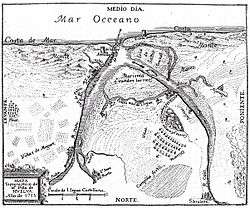Saltes Island
Saltes Island (Spanish: Isla Saltés) is a small fluvial island located in the Huelva River estuary in the province of Huelva, Andalusia, Spain. The island is part of the Odiel Marshes biosphere reserve.

Geography
Saltes Island is the southernmost island within the Odiel Marshes Natural Park, the second largest wetland in Andalusia. It lies at the confluence of the Odiel and Rio Tinto rivers.[1] The island is mostly swamp with sand-covered ridges up to 3 metres (9.8 ft) high.[2] Its soil hosts an important ecosystem of flora and fauna, including species of spoonbills, flamingos, egrets and storks.
History
Saltes Island and the nearby city of Huelva are possible sites of the semi-mythical city of Tartessos.[1] In his Ora Maritima, the Roman poet Avienus referred to Tartessos as the "island between two rivers." Previously, the Greek historian Strabo wrote of Phoenicians sailing to the area in the 8th century BC whose oracle told them to build a temple for Hercules. Historically, between the legend and Biblical references to Tarshish in the Book of Kings, Tartessos had come under Greek influence in the mid-seventh century BC.[3]
Archaeological investigation of the island has uncovered Roman installations related to fishing and sea salt production, as well as the remains of the city of Salthish, an eleventh-century Muslim settlement, part of the Taifa of Saltés and Huelva. Studies estimate that the city had a central fortress with a perimeter of 70m×40m. The population was devoted to metallurgy and the metal trades, taking advantage of the site's proximity to the northern mines whose minerals came to the city by the river now known as Rio Tinto.[4] The city was also engaged in fishing and trade due to its maritime location.
The city was slowly abandoned starting in circa 1052, when the Taifa was conquered by the Taifa of Seville, and continued to decline in Christian times.
On 17 July 1381, a naval confrontation of the Third Ferdinand War occurred in the vicinity of Saltes Island. Castilian Admiral Fernando Sánchez de Tovar's fleet sighted the Portuguese fleet commanded by João Afonso Teles de Menezes off the coast of the Algarve.[5] Outnumbered, de Tovar retreated towards Seville. The speed of the Castilian fleet caused the Portuguese to break formation, and several of the Portuguese ships attacked the property of fishermen on Saltes Island. De Tovar's retreat had been a ruse, however, and seeing the Portuguese in disarray the Castilians attacked in tight formation, capturing 22 of the 23 Portuguese galleys.[6]
References
- "The City of Huelva". Andalucia Costa del Sol Magazine.
- NGA Sailing Directions-Enroute: 2008 West Coast of Europe and Northwest Africa (11th Edition). National Geospatial-Intelligence Agency. 2009. p. 130. ISBN 978-1-577-85885-0.
- Williamson, H. G., Provan, I. W., & Boda, M. J. (2012). Let Us Go Up to Zion: Essays in Honor of H.G.M. Williamson on the Occasion of His Sixty-fifth Birthday. Leiden: Brill. p. 364.
- Terán, Rafael J. "Huelva, cencilla ciudad". Fundación Cruzcampo (in Spanish). Retrieved November 1, 2016.
- Pereira, António Rodrigues (1983). História da Marinha Portuguesa (in Portuguese). Lisboa: Escola Naval.
- Fernández Duro, Cesáreo (1995). La Marina de Castilla (in Spanish). Madrid. pp. 144–145. ISBN 978-84-86228-04-0.